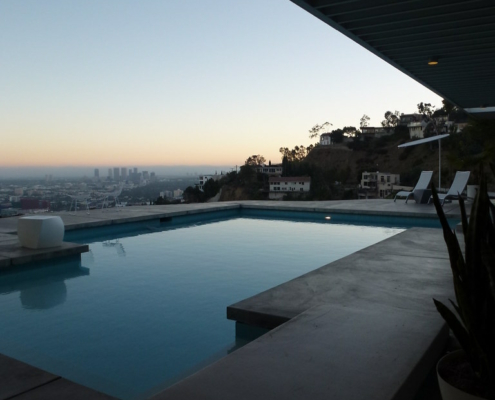

Stahl House (Case Study House #22)
Pierre Koenig | Website | 1960 | Visitor Information
1635 Woods Drive , West Hollywood 90069, United States of America

The Stahl House by Pierre Koenig (also known as Case Study House #22) was part of the Case Study House Program, which produced some of the most iconic architectural projects of the 20th Century. The modern residence overlooks Los Angeles from the Hollywood Hills. It was completed in 1959 for Buck Stahl and his family. Stahl envisioned a modernist glass and steel constructed house that offered panoramic views of Los Angeles when he originally purchased the land for the house in 1954 for $13,500. When excavation began, he originally took on the duties of both architect and contractor. It was not until 1957 that Stahl hired Pierre Koenig to take over the design of the family’s residence. The two-bedroom, 2,200 square foot residence is a true testament to modernist architecture and the Case Study House Program. The program was set in place by John Entenza and sponsored by the Arts & Architecture magazine. The aim of the program was to introduce modernist principles into residential architecture, not only to advance the aesthetic but to introduce new ways of life, both stylistically and as a representation of modern lifestyle. Koenig was able to hone in on the vision of Buck Stahl and transform that vision into a modernist icon. The glass and steel construction is the most identifiable trait of the house’s architectural modernism, however, way in which Koenig organized the spatial layout of the house, taking both public and private aspects into great consideration, is also notable. As much as architectural modernism is associated with the materials and methods of construction, the juxtaposition of program and organization are important design principles that evoke utilitarian characteristics. The house is “L”-shaped, completely separating the public and private sections except for a single hallway connecting them. The adjacent swimming pool, which must be crossed to enter the house, is not only a spatial division of public and private but it serves as the interstitial space in which visitors can best experience the panoramic views. The living space of the house is behind the pool and is the only part of the house that has a solid wall, which backs up to the carport and the street. The entire house is one large viewing box, capturing amazing perspectives of the house, the landscape, and Los Angeles. Oddly enough, the Stahl house was fairly unknown and unrecognized for its advancement of modern American residential architecture until 1960 when photographer Julius Shulman captured the pure architectural essence of the house in a shot of two women sitting in the living room overlooking the bright lights of the city of Los Angeles. That photo put the Stahl House on the architectural radar as an architectural gem hidden in the Hollywood Hills. The Stahl House is still one of the most visited and admired buildings today. It has undergone many interior transformations. Today, you will not find the same iconic 1960s furniture inside, but the architecture, the view, and the experience still remain.
Tags: Classic , Los Angeles
Information provided in part by: ArchDaily
Projects in West Hollywood
Bradbury building, caltrans district 7 headquarters, eames house, emerson college, getty center, griffith observatory, la county museum of art, petersen automotive museum, samitaur tower, sheats-goldstein residence, the broad museum, walt disney concert hall, wilshire grand.


- BUILDING MATERIALS
- BOOKS & RESOURCES
- HISTORICAL TIMELINE
- INFLUENTIAL ARCHITECTS
- RANDOM INSPIRATION
The Stahl House by Pierre Koenig | Case Study House #22

Perched on the Hollywood Hills with a commanding view of Los Angeles, the Stahl House, also known as Case Study House #22, is a paragon of mid-century modern architecture. Designed by Pierre Koenig and completed in 1960, this residence is an architectural masterpiece and a symbol of a particular era in Los Angeles, characterized by a burgeoning optimism and a new approach to residential design.
The Stahl House Technical Information
- Architects 1 : Pierre Koenig
- Location: 1636 Woods Drive, Los Angeles , California , United States
- Topics: Mid-Century Modern Houses
- Area: 210 m 2 | 2,300 ft 2
- Project Year: 1959-1960
- Photographs: Various, See Caption Details
If you don’t know the Stahl House, then you don’t know mid-century modern architecture. – Julius Shulman 3
The Stahl House Photographs

A Vision of Glass and Steel
The journey of the Stahl House began in 1954 when Buck Stahl purchased a lot that was considered unbuildable. His vision was clear—a home that embraced its surroundings with vast expanses of glass to capture the sprawling cityscape. In 1957, Koenig, known for his proficiency with industrial materials, was commissioned to realize this vision. The result was a structure of steel and glass that was both minimalistic and expressive.
Design and Layout
Koenig’s design was a masterclass in the use of industrial materials in residential architecture. The house is distinguished by its “L” shaped plan, separating public and private spaces through a simple yet effective layout. Large, 20-foot-wide panes of glass form the majority of the walls facing the view, offering unobstructed panoramas of Los Angeles.
The design also cleverly incorporates the landscape into the living experience. The swimming pool, positioned between the wings of the house, not only serves as a physical buffer separating the living spaces but also as a visual corridor to the city beyond.
I design for the present, with an awareness of the past, for a future which is essentially unknown. – Pierre Koenig 2

Iconic Status and Architectural Significance
Julius Shulman’s photography cemented the Stahl House’s iconic status. In a series of images that have become synonymous with mid-century modern architecture, Shulman captured the essence of the house. These photographs highlight the house’s integration with its surroundings and open, transparent design.
The Stahl House was included in the Case Study House program, which aimed to reimagine residential architecture post-World War II. Case Study House #22 became an influential model showcasing the possibilities of modernist aesthetics in suburban settings.
Cultural Impact and Legacy
Over the years, the Stahl House has transcended its role as a private residence to become a cultural landmark. It has been featured in numerous films, commercials, and fashion shoots, each time underscoring its timeless appeal and architectural significance.
Despite its fame, the house remains a family-owned property, preserved as the Stahls left it. The family offers tours, allowing architecture enthusiasts to experience the space and its spectacular views firsthand.
The Stahl House Plans

The Stahl House Image Gallery

About Pierre Koenig
Pierre Koenig was a pioneering American architect, born on October 17, 1925, in San Francisco. Renowned for his influential contributions to mid-century modern architecture, Koenig is best known for his work in the Case Study House program, particularly the iconic Case Study House #22, or Stahl House. His designs emphasized industrial materials like steel and glass, integrating buildings seamlessly into their environments while promoting sustainability through the use of prefabricated materials. A long-time professor at the University of Southern California, Koenig’s legacy continues to influence architectural practices and education. He passed away on April 4, 2004, leaving behind a significant impact on the landscape of Southern California architecture.
Notes & Additional Credits
- Client: Buck Stahl
- Case Study Houses by Elizabeth A. T. Smith
- Modernism Rediscovered by Julius Shulman
- Pierre Koenig: Living with Steel by Neil Jackson
Share this:
Leave a reply cancel reply.
This site uses Akismet to reduce spam. Learn how your comment data is processed .
- Topics Overview
- Influential Architects
- 2020’s
- 2010’s
- 2000’s
- 1990’s
- 1980’s
- 1970’s
- 1960’s
- 1950’s
- 1940’s
- 1930’s
- 1920’s
- American Architecture
- Austrian Architecture
- British Architecture
- Chinese Architecture
- Danish Architecture
- German Architecture
- Japanese Architecture
- Mexican Architecture
- Portuguese Architecture
- Spanish Architecture
- Swiss Architecture
- Auditoriums
- Cultural Centers
- Installations
- Headquarters
- Universities
- Restaurants
- Cementeries
- Monasteries
- City Planning
- Landscape Architecture
- Top Book Recommendations
- Top Drawing Tools Recommendations
- Gifts for Architects
Email address:
Timeless Architecture

- Terms of Service
- Privacy Policy

IMAGES
VIDEO